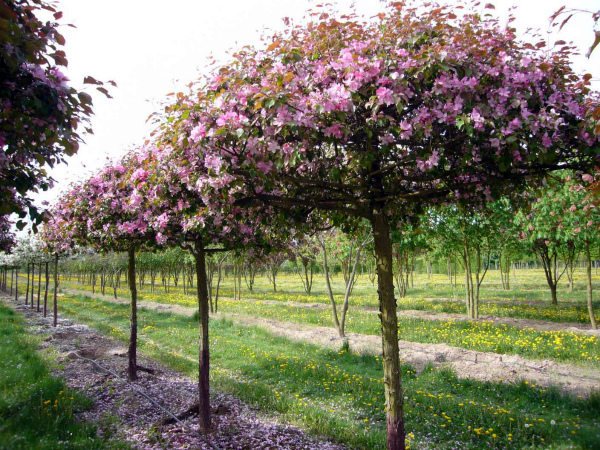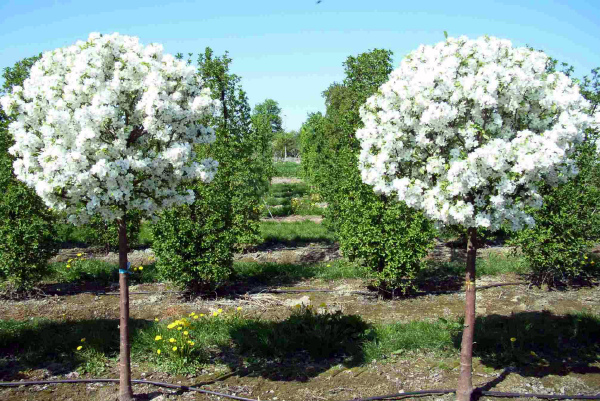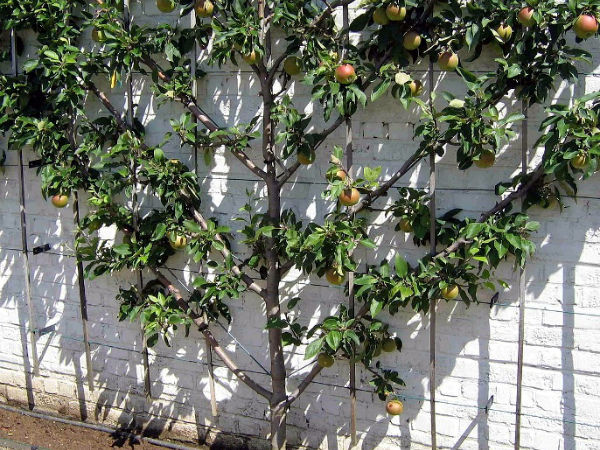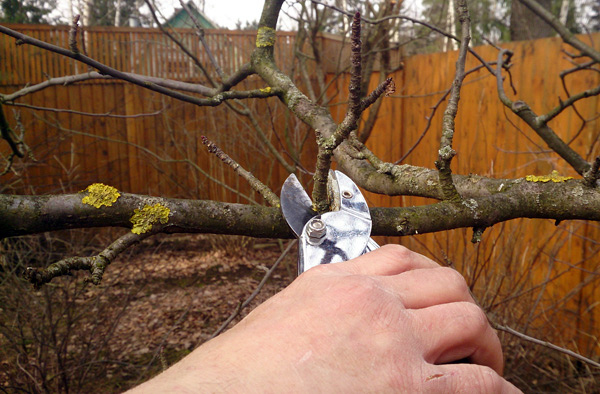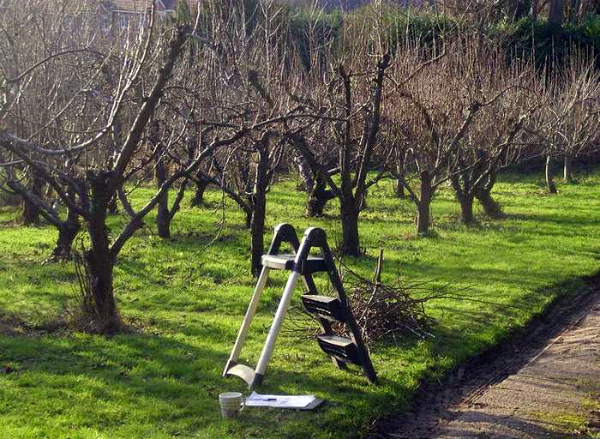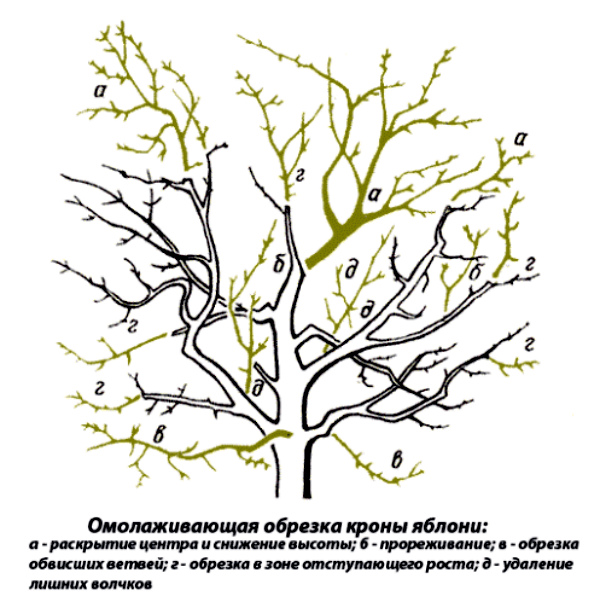How to properly form the crown of a young apple tree
Content
Types of crowns
Crown formation is a responsible and difficult process. In different cases and when growing different varieties, different methods will work. To begin with, it is worth deciding whether the tree grows in a free area, close to the fence or wall. It is important to decide how and when to prune the branches correctly so that the apples are abundant and easy to harvest. It depends on this what shape must be given to the crown, when it is formed, and what diameter it will have.
The sparse-tiered crown is one of the most popular types that retains the natural characteristics of an untouched tree.
This scheme is recommended when growing vigorous and medium-sized varieties, since 5 skeletal branches can be formed on a 1st order trunk. In the lower part, two adjacent or contiguous branches are left, the rest are thinned out so that the interval between them is about 60–65 centimeters. The upper branch is located at a height of about 2 meters. They are formed at an angle of 40–45 ° to the row line to simplify and create “flat” row spacings. Having decided on the space between the supporting branches, semi-skeletal forks of 1–2 centimeters are formed on them. There should be a distance of 50 centimeters between semi-skeletal groups.
A rounded, fusiform crown is another way to form the green part of an apple tree. This type is characterized by a uniform dispersion of the branches around the central conductor. The lower tier consists of 6 branches with an inclination of 25–35 °. The number of branches in the higher tiers will vary depending on the needs. The diameter and height of the crown depends on the strength of the tree's growth. Often, with such pruning, the tree reaches 2-3 meters in height, and 3-4 meters in width. The lower part of such a crown has openings convenient for working with branches.
The flat fusiform crown is formed on the basis of two opposite skeletal branches and their semi-skeletal branches. To weaken growth and stimulate fruiting, the supporting branches are tilted 55-60 ° from the vertical, and the branches located above are placed completely horizontally. Semi-skeletal forks are placed at intervals of 25–35 centimeters, with 5–6 branches per tier. The more the crown grows, the more it is taken to the ring.
The cup-shaped crown is great for those varieties that do not have a long lifespan. With this formation, three skeletal branches are left, at an angle of 120 °, cutting off to 40 centimeters. This makes it possible to form forks in the future. With this scheme, the central conductor is cut just above the upper branch.Subsequently, you need to thin out the central part of the crown so as not to thicken the diameter.
Formation of the apple tree crown according to the “vertical palmette” type allows growing apple trees along walls and fences. However, the formation of such a crown will take at least 2-3 years. The branches are placed in one tier so that they form a flat tier; for this, two branches are left on the central conductor, keeping at least 80 centimeters of free space between the tiers. The emerging shoots are tilted to facilitate fruiting. The diameter of such a crown rarely exceeds 2 meters, and the height depends on the number of tiers formed.
When to trim
Having decided on the shape of the future crown, we turn to one of the main questions: when is it right to start forming the crown of an apple tree. To do everything right, you need to navigate the timing and understand how the tree develops. Apple pruning is carried out on different occasions in autumn or spring.
If you decide to prune the apple tree in the fall, you should wait until the leaves have completely fallen off, and the tree will prepare for winter. But it's better not to delay. After the tree “falls asleep”, it is not recommended to prune branches. Not capable of rapid regeneration in winter, the apple tree will not be able to overgrow the cut sites. This is dangerous due to further damage and rotting of the tree. However, if the old, rotten, spoiled branches are removed before the frost sets in, the tree will prepare for winter correctly and will yield a large harvest next year.
Pruning in the fall is more suitable for already grown trees. And at the stage of crown formation, it is best to remove excess branches before the beginning of the growing season of the apple tree - in the spring. It is worth doing this before buds appear and bloom on the tree.
In either case, it doesn't matter in the fall or spring, you prune your apple tree. It is worth remembering that the places of the cuts must be “isolated”, that is, lubricated with a garden wart. This will prevent the wounds from freezing and festering. Festering trees bear much less fruit, because most of the "efforts" of the plant will be spent on repairing damage, and not on fruiting.
Pruning technique
The pruning technique depends on what type of crown you are going to form. However, for all techniques, there are several general characteristic recommendations, regardless of what end result you want to achieve:
- Firstly, the branches are best cut off in the earliest period of apple growth, in the first year of its growth. Thus, you spend less energy of the tree on healing wounds, which means that you will receive the first harvest and dense foliage immediately.
- Secondly, pruning is best done in the spring, not in the fall. A young seedling will spend not so much energy on regeneration. The diameter of the branches, and therefore the diameter of the damage, will not be as large as if you began to form the crown of an already mature tree.
- Thirdly, you need to leave only the strongest, well-located branches extending from the trunk at a right or close to a right angle. This will allow you to set the crown the correct shape, in which the harvest will be convenient, and the growth of the fruit will be plentiful.
- A few years after the initial pruning (usually after three years), the branches will have to be pruned in the fall in order to remove damaged and non-bearing branches, letting the full potential of the plant to properly maintain the crown shape and fruiting.
Rejuvenating pruning of old apple trees
Old apple trees can be rejuvenated - cut off old branches, stimulating the growth and restoration of the reproductive functions of the tree. In addition, pruning will help to properly distribute space between your trees so that they do not get confused by branches, and to correct the diameter of the crown. Perhaps it will be possible to grow something else between them.
Rejuvenating pruning is carried out in the fall and only if the tree is healthy and whole, its trunk is not damaged, and the skeletal branches are strong and developed.All old, dried, damaged branches should be removed, and with them the branches that grow towards the trunk, inside the crown, should be removed.
When choosing branches for removal, it is better to remove large and non-fruiting branches than small ones and those that bear fruit. Getting rid of the need to supply large and barren branches with juice and nutrients, the tree will redirect the resource to the growth of new branches and directly fruiting.
Depending on the variety of the apple tree and on the duration of its growth, it is also recommended to open the top. That is, at a height of just over 3 meters, it is worth cutting off the top of the trunk. Thus, you allow new branches to grow directly from the cut, as well as adjust the diameter.
Video "Spring pruning of apple trees"
This video is about how to properly prune a young apple tree in spring without harming it and preserving its strength for a good harvest.

